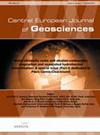Petrology of potassic alkaline ultramafic and carbonatitic rocks from Planalto da Serra (Mato Grosso State), Brazil
引用次数: 4
Abstract
The Planalto da Serra igneous rocks form plugs, necks and dykes of carbonate-rich ultramafic lamprophyres (aillikites and glimmerites with kamafugitic affinity) and carbonatites (alvikites and beforsites). Phlogopite and/or tetraphlogopite, diopside and melanitic garnet are restricted to aillikitic rock-types, whereas pyroclore occurs only in carbonatites. Aillikites and carbonatites are altered to hydrotermalites, having chlorite and serpentine as dominant minerals. Planalto da Serra igneous rock association has kamafugitic affinity (i.e. effusive, ultrapotassic. High LREE/HREE fractionation, incompatible elements data and Sr-Nd isotopes, suggest that the K-ultramafic alkaline and carbonatite rocks originated from a variably metasomatized mantle source enriched in radiogenic Sr. Crustal contamination is negligible or absent. Age values of 600 Ma rule out the geochronological relationship between the investigated intrusions and the Mesozoic alkaline bodies from the Azimuth 125° lineament. The TDM model ages allow to conclude that Planalto da Serra magma is derived from the partial melting of a mantle source metasomatised by K-rich carbonatated melt during the Early to Late Neoproterozoic. On the basis of alkaline magmatism repetitions at 600 Ma and 90–80 Ma we question the subsistence of a stationary mantle plume for so long time.巴西Planalto da Serra(马托格罗索州)钾碱性超基性和碳酸盐岩岩石学
Planalto da Serra火成岩形成了富含碳酸盐的超镁铁质煌斑岩(与马马辉石有亲和关系的亮辉岩和闪辉岩)和碳酸盐(岩屑岩和闪辉岩)的塞状、颈状和脉状。辉云母和/或四辉云母、透辉石和黑质石榴石仅存在于无晶质岩石类型中,而辉绿石仅存在于碳酸盐岩中。爱丽石和碳酸盐蚀变为水温石,绿泥石和蛇纹石是主要矿物。Planalto da Serra火成岩组合具有kamafutic亲和性(即热流、超经典)。高LREE/HREE分异、不相容元素数据和Sr-Nd同位素表明,钾基超镁质碱性和碳酸盐岩起源于富含放射性成因sr的变交代地幔源,地壳污染可以忽略或不存在。600 Ma的年龄值排除了所研究的侵入体与方位角125°剖面中生代碱性体的年代学关系。TDM模型年龄表明,Planalto da Serra岩浆来源于新元古代早期至晚期富钾碳酸化熔融交代的地幔源的部分熔融。在600 Ma和90 ~ 80 Ma碱性岩浆活动的基础上,我们对静止地幔柱在这么长时间内的存在提出了质疑。
本文章由计算机程序翻译,如有差异,请以英文原文为准。
求助全文
约1分钟内获得全文
求助全文
来源期刊

Central European Journal of Geosciences
GEOSCIENCES, MULTIDISCIPLINARY-
自引率
0.00%
发文量
0
审稿时长
>12 weeks
 求助内容:
求助内容: 应助结果提醒方式:
应助结果提醒方式:


